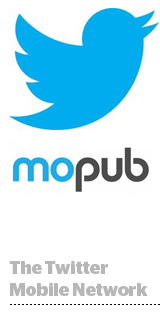 Twitter has acquired MoPub, which provides ad management services to thousands of mobile publishers. The move gives Twitter considerable advertising reach in mobile, including real-time bidding inventory through MoPub’s Marketplace mobile ad exchange.
Twitter has acquired MoPub, which provides ad management services to thousands of mobile publishers. The move gives Twitter considerable advertising reach in mobile, including real-time bidding inventory through MoPub’s Marketplace mobile ad exchange.
Kevin Weil, Twitter’s VP of Product for Revenue, wrote in a blog post:
“The two major trends in the ad world right now are the rapid consumer shift toward mobile usage, and the industry shift to programmatic buying. Twitter sits at the intersection of these, and we think by bringing MoPub’s technology and team to Twitter, we can further drive these trends for the benefit of consumers, advertisers, and agencies.
The MoPub team has built a leading mobile ad exchange, and their focus on providing transparency to advertisers and publishers aligns with our values. We’ll continue to invest in and improve their core business. In particular, we think there is a key opportunity to extend many types of native advertising across the mobile ecosystem through the MoPub exchange.”
TechCrunch covered the news first, pegging the value of the transaction at $350 million in stock.
Among MoPub’s publisher customers are WordPress, Opentable, Flixster and BET Networks. In May, MoPub said it reached a $100 million revenue run rate.
The move may have implications for Twitter’s own data. For instance it could potentially push interest and intent data it off its own properties into biddable placements on other sites, noted Andrew Shebbeare, chief strategist and digital agency Essence.
“Any acquisition that helps Twitter leverage the richness of their audience data more widely will be very interesting to advertisers, especially in mobile,” Shebbeare said. “With the small screen medium so much less ‘data liquid’ than the desktop, acquiring a market leading exchange and layering in that proprietary perspective seems like a smart move.”
Shebbeare added the deal “reaffirms the strength of Google-Facebook-Amazon-Twitter as the masters of audience data. Their relationships with users have unparalleled breath and depth. I am sure this trend will continue as they compete to own the ad impression as well as the data behind it.”
MoPub could help Twitter increase its reach in the all-important mobile space. According to a recent comScore report, Twitter lagged far behind Facebook and Google in terms of smartphone browser site and apps reach.
The July 2013 “Smartphone Subscriber Market Share” report, contained stats showing the reach of smartphone sites and apps in the US based on 114 million smartphone users. Google and Facebook came out on top with a roughly 90% reach among browser sites. Facebook took the lead in mobile apps with a 76.1% reach. Google’s various apps (YouTube, Google Play, Google Maps, Gmail) ranged in reach from 45% (Gmail) to 53.7% (YouTube).
Under “Smartphone Browing + App Audience,” Twitter.com took 15th place with a 29% reach. This result make sense when you consider how people access the various sites and apps, commented Jake Wengroff, founder of consultancy JXB1 Social Business.
“When people are tweeting, that tweet could often come in on Foursquare, a Yelp review, or Facebook. The tweets are being pushed through other sites that have been synced with Twitter, which makes it harder to measure Twitter’s true engagement,” he said.
Considering that Twitter is often used as a news aggregator, its performance is comparable to other news sites, added Kate Dreyer, Lead Corporate Communications Manager at comScore. “If you think about how people actually use Twitter,” Dreyer noted, “Which is often to keep up with news – then Twitter’s reach is right on par with other similar properties, e.g. CBS Interactive.”
At the same time, Facebook is acting more like Twitter. The behemoth social network has recently added hashtags, embedded posts and trending topics similar to Twitter, and is now highlighting conversations. Starting with Buzzfeed, CNN, NBC’s Today Show, Sky TV, and Slate, Facebook is giving media companies the ability tap into its member data to highlight what’s trending on the social network through a demographic breakdown of the users.
Zach Rodgers contributed.














